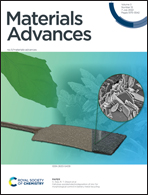Ternary-phase nanostructure W3P/WP/W for high-performance pH-universal water/seawater electrolysis†
Abstract
With the rapid availability of electricity generated from renewable energy resources, the desire to realize industrialized low-carbon hydrogen production through direct electrolysis of water is no longer an illusion. However, the requirement of traditional electrolysis technology for large amounts of freshwater electrolytes remains a great challenge. Seawater seems to be an ideal substitute for freshwater because of its abundant reserves. However, harsh requirements for electrocatalysts in seawater electrolysis significantly limit its wide application. Here, we report an efficient ternary-phase catalyst (W3P/WP/W) for the hydrogen evolution reaction (HER). The metal-rich phosphide, W3P, reappears in our field of vision after more than 50 years through a more straightforward synthesis and acts as the active phase in the HER for the first time. W3P/WP/W outperforms most counterparts in pH-universal electrolytes. For freshwater electrolytes, it only requires 94 mV (acidic conditions) and 146 mV (alkaline conditions) to attain a current density of 10 mA cm−2 with an extremely low mass loading. And for seawater, in KOH + seawater, only 0.966 V and 1.441 V cell voltages are needed to reach current densities of 10 and 100 mA cm−2. Furthermore, an ion exchange resin pretreatment method is used to meet the demands of proton exchange membrane (PEM) electrolyzers for neutral electrolytes. In this electrolyte, the current decay of the highly non-toxic catalyst in continuous operation for 200 hours is almost negligible. The abundant vacancies, defects and the synergistic effect resulted in the outstanding performance. Consequently, the novel pH-universal electrocatalyst is promising for both freshwater and seawater electrolysis to realize large-scale green hydrogen production.



 Please wait while we load your content...
Please wait while we load your content...